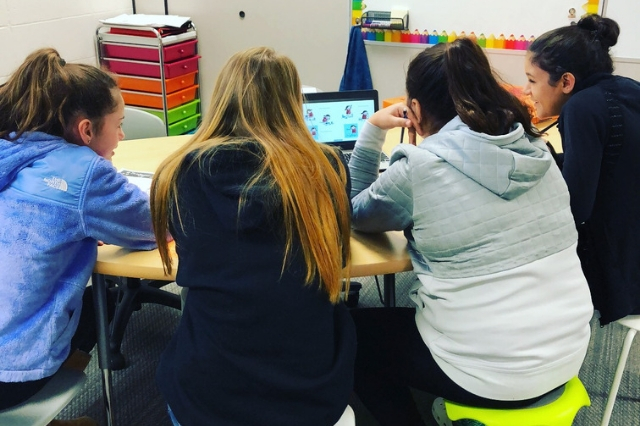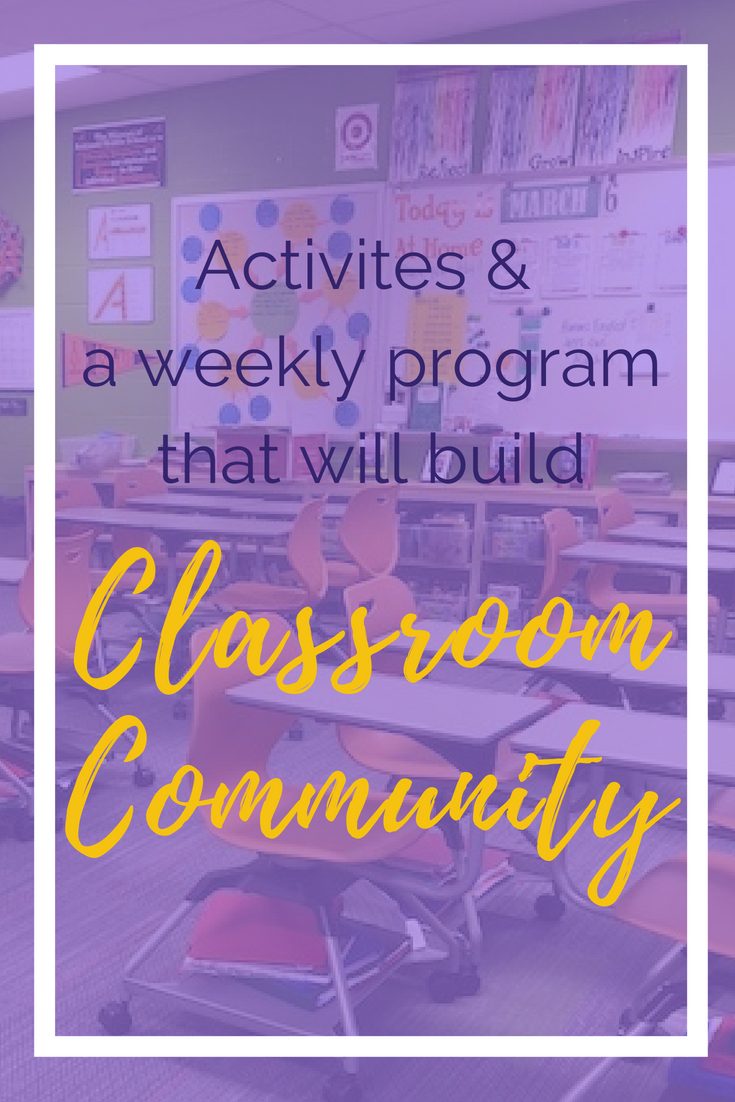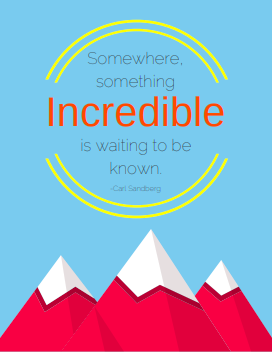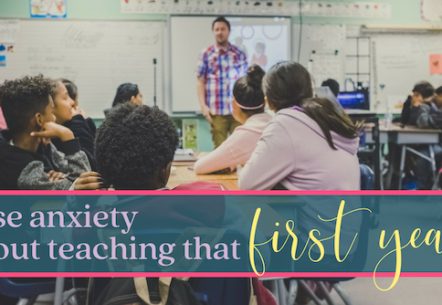One the greatest aspects to establish in the classroom, right from the start, is a sense of community. Classroom community is important for students to feel they are in a safe place to share ideas and take some risks. When they feel the environment around them will support them even if they didn’t get the right answer they will still be willing to try. Their willingness to try will make for a much more productive class period each day.
Now, this all sounds great, but it can often be difficult to establish a community within a middle school classroom. For one thing, middle schoolers can be pretty opinionated. By the time they get to 8th grade they may have been burned by others and until you prove them wrong they are convinced you will be the same kind of teacher. Middle schoolers are also big fans of drama. They often carry a grudge like a new momma carries her newborn. They cuddle it and feed it and watch it grow.
Some of the links found in this post are affiliates. This means if you make a purchase after clicking through we will receive a small compensation at no extra cost to you. Thank you in advance for your support and please know that we only endorse products we use and love.
This can make creating a class community a difficult process. That is why it’s best to start as soon as possible.
Here is an idea that was sparked by a teacher I connected with through Instagram. If you have read the book or watched the movie Wonder then you know what I mean by Mr. Browne’s precepts. He was a teacher who started his class with a precept, a word I had to look up in the dictionary because I’d never heard it before reading Wonder. Precept is defined as a rule or direction dictating a way you should act or behave. To me using this word makes so much more sense than calling them inspirational quotes, or even using just inspirational quotes.
The plan
Hashtags are all the rage so I’m going to use #MotivationMonday to kick off each week. Even if we have a holiday Monday and start the week on Tuesday. When students come in and get settled we will start with our posted precept. Read the precept out loud together then discuss what it means. This is a quick, 5-minute conversation.
As the week moves along notice when kids are living out the week’s precept. Tell them how they are demonstrating it and call them out to their classmates for doing so. This will allow everyone to see what the precept in action looks like. By Thursday all students will need to cast their vote for the classmate who they felt lived out the precept. This will be done through a simple Google Form that students can find on our class blog. The form asks simple questions: voting student’s name, nominee’s name, why they deserve to be recognized. At the end of the day Thursday I will go through the votes and the student with the most votes will be awarded a small laminated version of the precept poster. They will also receive a printed list of the reasons why they were deserving of this precept. All voters names will be kept anonymous. It will be up to students if they would like to share that they voted for that student and why.
In class on Friday, we will spend a few minutes celebrating that student for their outstanding accomplishment. It is my hope that this will encourage positive behavior. Our class motto is a positive presence & a positive participant. Using the weekly precepts will help support and uphold this message.
If you would like to purchase a school year’s worth of precept posters and awards you can find them in my Teachers Pay Teachers store.
Set the stage with other activities
When you teach in a class that has multiple levels of learners, meaning you’ll need to pull them into small groups for many of the lessons, it’s a good idea to start building a community that also recognizes differences. As a teacher who has an intervention specialist for every class it’s no secret to the kids that there is a second teacher in the room for a reason. The kids who are on IEPs know they need extra support and the minute you ask them to join a group away from the big group they often feel stupid. The stigma is real and if we don’t treat it in a way that can make these kids feel comfortable they will continue to see themselves as a label.
Caterpillars and Butterflies
Over the summer I kept hearing about or reading about how caterpillars change into butterflies. This made me think about the obvious theme of metamorphosis. Starting out as something small with little skills and turning into something more beautiful and grand. But then I started to think about the life of a caterpillar and the life of a butterfly separately.
As a caterpillar, they crawl on their bellies and eat leaves. In that state, those things are good for them. As butterflies, they now get around with wings, totally new skills because of a totally new body. They now eat nectar. Again, a totally new food source which is perfect for nourishing their totally new bodies. (Sorry, I’m not a science teacher so this is really basic here, but I promise a good point is about to be made.) As caterpillars, they needed to eat a certain kind of food to fuel the body they had at the time. It’s what was best for them. Imagine if a caterpillar tried to eat nectar rather than the leaves it’s body truly needed. They probably wouldn’t grow and they would most likely be super hungry all the time. It’s the same for us.
If we try to “feed” ourselves something that we aren’t ready for or can’t grasp the concept of right now then we are going to get frustrated and shut down. It’s important for us to know what we need in order to grow. Or it’s important for students to understand how they learn best in order to actually retain knowledge.
Like caterpillars, we can often evolve over time. If we build up our knowledge enough to transform our weaknesses into strengths we become something new, a butterfly. Now we have to figure out how this new self learns and grows. That can often mean trying something we have never tried before because we are something (or at least our mindset might be something) we have never been before.
This little breakdown of the metamorphosis theme is meant to help students think about how they should be aware of their personal learning style AND understand that it can change. It’s possible to train yourself to be a better learner in a style you may not have been successful with previously.
Why this matters
For example, I’m the worst singer! I listen to the radio in the car, but I’m not really a music kind of person. However, when I had my children I discovered that singing to them soothed them to sleep. I’m still baffled by this! Plus, I’m so bad with music that I really only know two songs. The ABC’s (yes I’m a total ELA nerd) and Twinkle Twinkle Little Star. Do you know that my two-year-old has been singing ALL of the correct words to Twinkle Twinkle since she could speak sentences? I discovered that she learns things when they are in a musical lyric. So I started making up songs to teach her things. I’m not about to go live with these songs, but she is learning and so am I.
The first week of school my read aloud will be Hermie by Max Lucado. It tells the story of a caterpillar who desperately wants to be special like so many other bugs. Then when he becomes a butterfly he recognizes that he hadn’t become his true self. I’ll ask the kids what they think is Hermie’s greatest lesson learned. Their answers should reflect ideas about being ok with who you are or where you are at presently. That we don’t need to desire or try to be something we are not. Especially because we all have the potential to become someone greater than we are today, at this moment.
Next, we will all draw ourselves as the butterflies we see for our future selves. Students who feel comfortable drawing from scratch will get a blank white paper and those who need an outline to get started can have a copy. They will color and cut out their butterflies and we will hang them in the classroom.
My next major point to students will be noticing how different each butterfly was drawn. I’ll make an observation that the process inside a chrysalis is probably not the same for a bright blue wing as it would be for a marbled yellow and black wing. That means that in order to be formed into a butterfly each one might need something different to achieve the end result. The same idea applies to our classroom, each student will need a specific path of lessons to achieve mastery of a skill.
Now we have established the idea that we all have the potential to be something different than we are right now and in order to get there, it can look different than the person sitting next to us. Ultimately creating a safe space where different is good.
Now is the time to ask students what goals they need to set in order to become that butterfly they envision. What new skills does this butterfly have that the caterpillar didn’t have or wasn’t very good at? What goals would help that butterfly gain these skills?
Keep in mind this whole class activity is a metaphor!
I would love to hear from any of the teachers who give this approach to classroom community a try. Share in the comments how or if you plan to give this a go.







